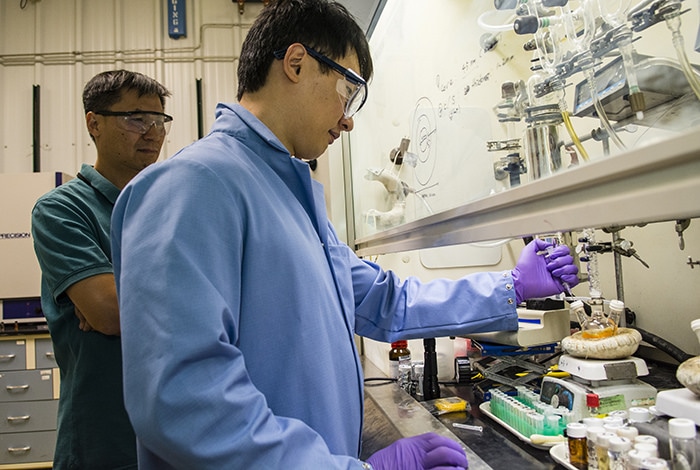Oct 18 2017
One of the keys to making miniature laser devices such as ophthalmic surgery scalpels function even more efficiently is the use of miniature semiconductor particles, known as quantum dots.
In a recent research conducted by Los Alamos National Laboratory’s Nanotech Team, the nanometer-sized dots are being doctored, or “doped,” with extra electrons, a treatment that pushes the dots ever closer to creating the preferred laser light with less stimulus and energy loss.
 Los Alamos National Laboratory Chemist Jaehoon Lim works on an apparatus that synthesizes quantum dots along with Los Alamos researcher Young-Shin Park (also with the University of New Mexico Center for High-Technology Materials). (Credit: Los Alamos National Laboratory)
Los Alamos National Laboratory Chemist Jaehoon Lim works on an apparatus that synthesizes quantum dots along with Los Alamos researcher Young-Shin Park (also with the University of New Mexico Center for High-Technology Materials). (Credit: Los Alamos National Laboratory)
When we properly tailor the compositional profile within the particles during their fabrication, and then inject two or more electrons in each dot, they become more able to emit laser light. Importantly, they require considerably less power to initiate the lasing action.
Victor Klimov, Leader of the Nanotech team
So as to force a material to discharge laser light one has to achieve a “population inversion,” that is, making the number of electrons in a higher-energy electronic state surpass the number that are in a lower-energy state. To accomplish this condition typically, one applies an external stimulus (electrical or optical) of a specific power, which should surpass a critical value termed the “optical-gain threshold.” In a recent paradigm-changing development, the Los Alamos team showed that by integrating more electrons into their specially engineered quantum dots, they can decrease this threshold to virtually zero.
A typical lasing material, when stimulated by a pump, absorbs light for a time before it begins to lase. On the way to lasing, the material changes through the state of “optical transparency” when light is neither amplified nor absorbed. By integrating additional charge carriers to their quantum dots, the Researchers were able to block absorption and produce the state of transparency without outer stimulation. This suggests that even very weak pumping can now trigger lasing emission.
Another vital ingredient of this research is a new type of quantum dots with their interiors doctored to maintain the lasing-active state for a lot longer than normal particles do. Typically, the presence of additional electrons would destroy lasing because quantum dot energy is rapidly emitted not as a photon stream but wasteful heat. The new Los Alamos study design prevents these parasitic losses, redirecting the energy of the particle into the emission channel.
These studies open exciting opportunities for realizing new types of low-threshold lasing devices that can be fabricated from solution using a variety of substrates and optical cavity designs for applications ranging from fiber optics and large-scale lasing arrays to laser lighting and lab-on-a-chip sensing technologies.
Victor Klimov, Leader of the Nanotech team
The research, published recently in the journal Nature Nanotechnology, has been authored by project members Kaifeng Wu (a Los Alamos Director’s Postdoctoral Fellow), Young-Shin Park (Guest Scientist, University of New Mexico), Jaehoon Lim (Los Alamos Postdoctoral Research Associate) and Victor I. Klimov (Laboratory Fellow, Project Leader).